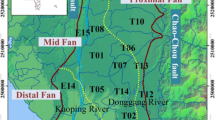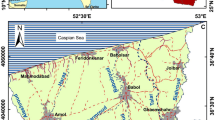Abstract
The present study concerns the application of a numerical approach to describe the influence of anthropogenic modifications in surface flows (operation of a projected reservoir) on the freshwater-seawater relationships in a downstream coastal aquifer which has seasonal seawater intrusion problems (River Verde alluvial aquifer, Almuñécar, southern Spain). A steady-state finite element solution to the partial differential equation governing the regional motion of a phreatic surface and the resulting sharp interface between fresh water and salt water was used to predict the regional behavior of the River Verde aquifer under actual surface flow conditions. The present model approximates, with simple triangular elements, the regional behavior of a coastal aquifer under appropriate sinks, sources, Neumann and open boundary conditions. A steady-state solution to this numerical approach has been shown to precisely calculate freshwater heads, saltwater thicknesses, and freshwater discharges along steeply sloping coasts. Hence, the adequate treatment and interpretation of the hydrogeological data which are available for the River Verde aquifer have been of main concern in satisfactorily applying the proposed numerical model. Present simulated conditions consider steady-state yearly averaged amounts of external supplies of fresh water in order to determine the influences of the projected Otívar reservoir on the further behavior of the River Verde coastal aquifer. When recharges occur at the coastline, essentially because of freshwater deficits due to groundwater overexploitation, a hypothesis of mixing for the freshwater-saltwater transition zone is made in order to still allow the model to continue calculating groundwater heads under the sea level, and, as a consequence, the resulting seawater intrusion and recharges of saltwater from the sea. Simulations show that a considerable advance in seawater intrusion would be expected in the coastal aquifer if current rates of groundwater pumping continue and a significant part of the runoff from the River Verde is channeled from the Otívar reservoir for irrigation purposes.
Similar content being viewed by others
Author information
Authors and Affiliations
Additional information
Received: 20 November 1996 · Accepted: 24 February 1997
Rights and permissions
About this article
Cite this article
Padilla, F., Benavente, J. & Cruz-Sanjulián, J. Numerical simulation of the influence of management alternatives of a projected reservoir on a small alluvial aquifer affected by seawater intrusion (Almuñécar, Spain). Environmental Geology 33, 72–80 (1997). https://doi.org/10.1007/s002540050226
Issue Date:
DOI: https://doi.org/10.1007/s002540050226




